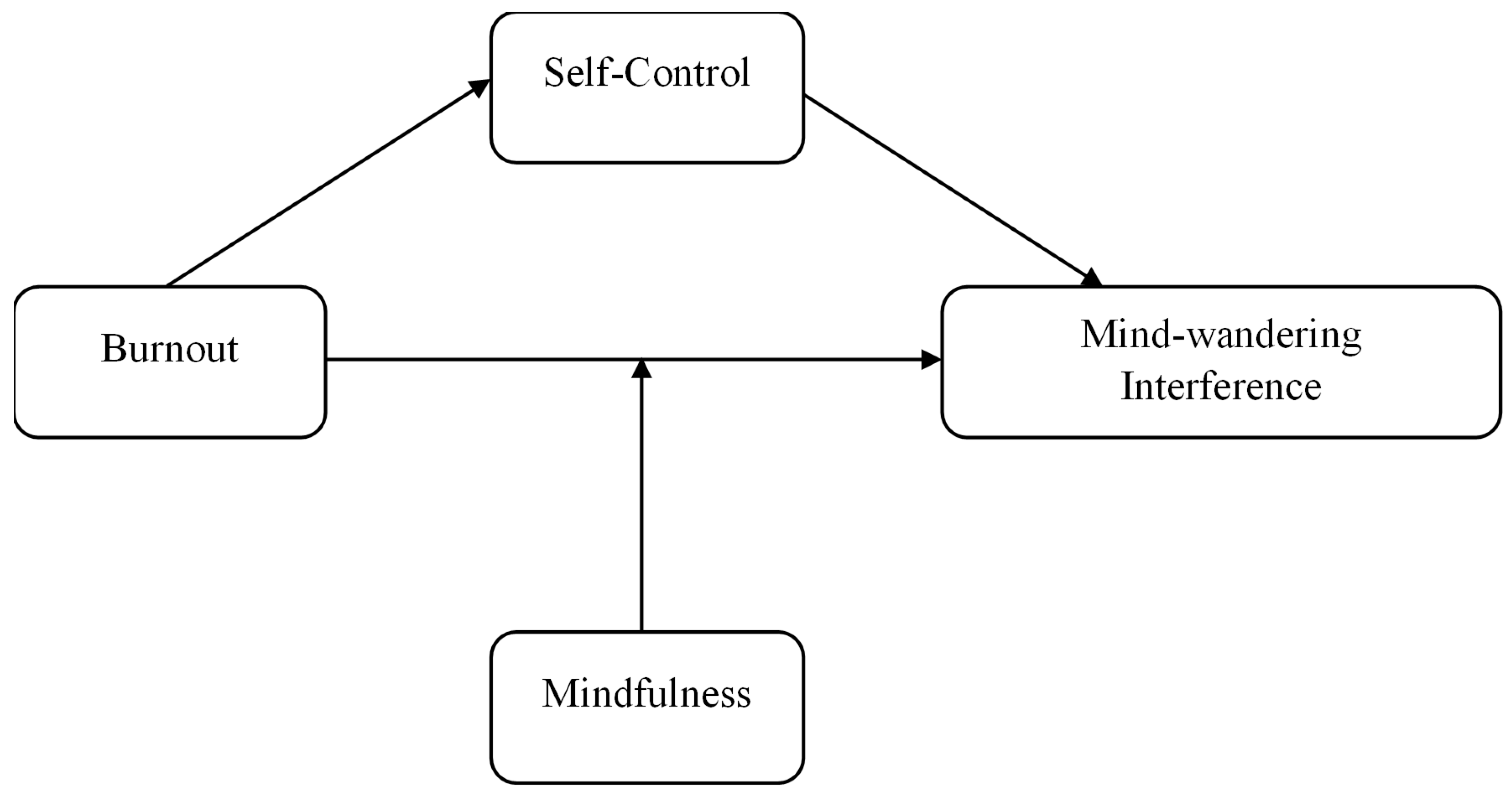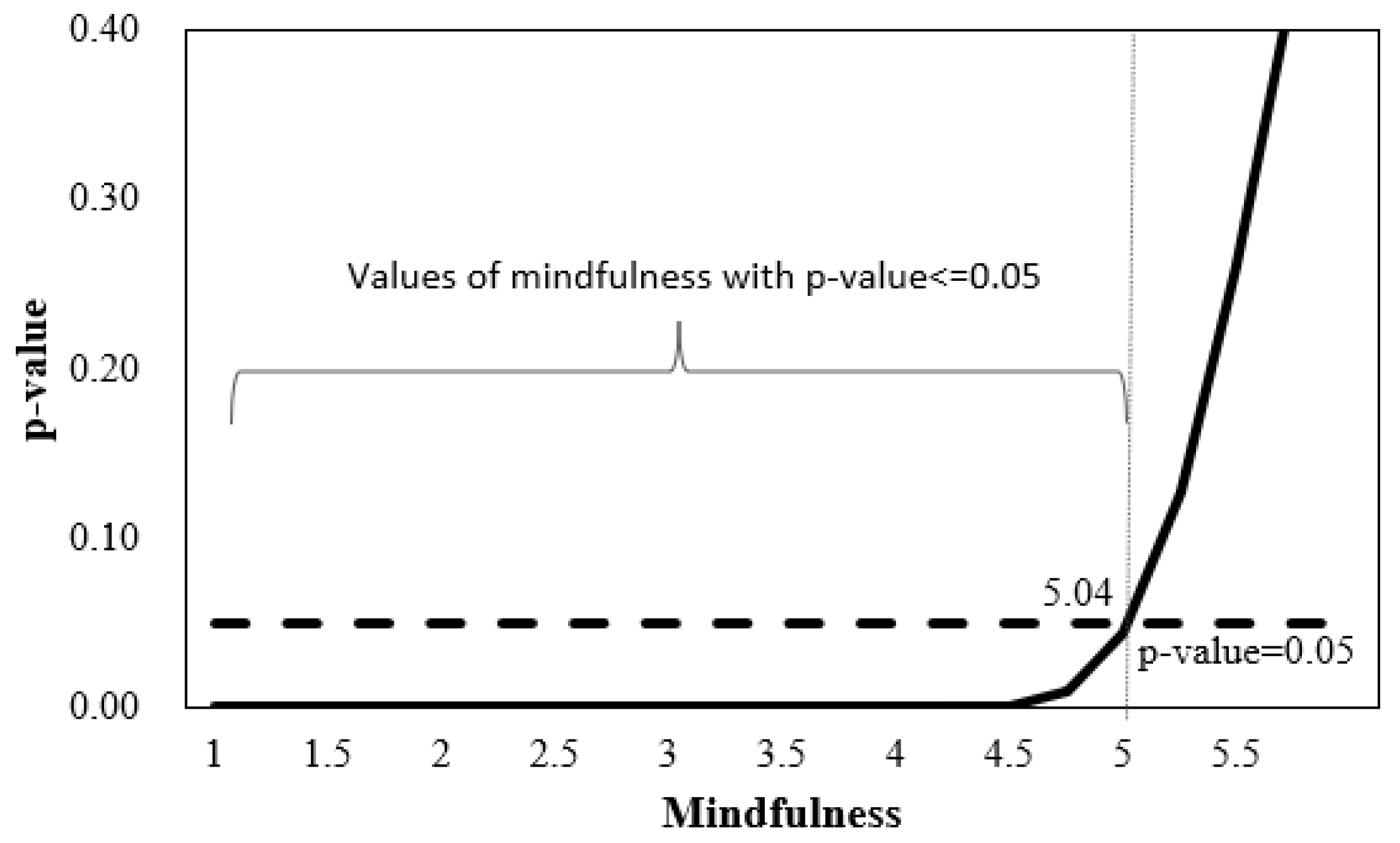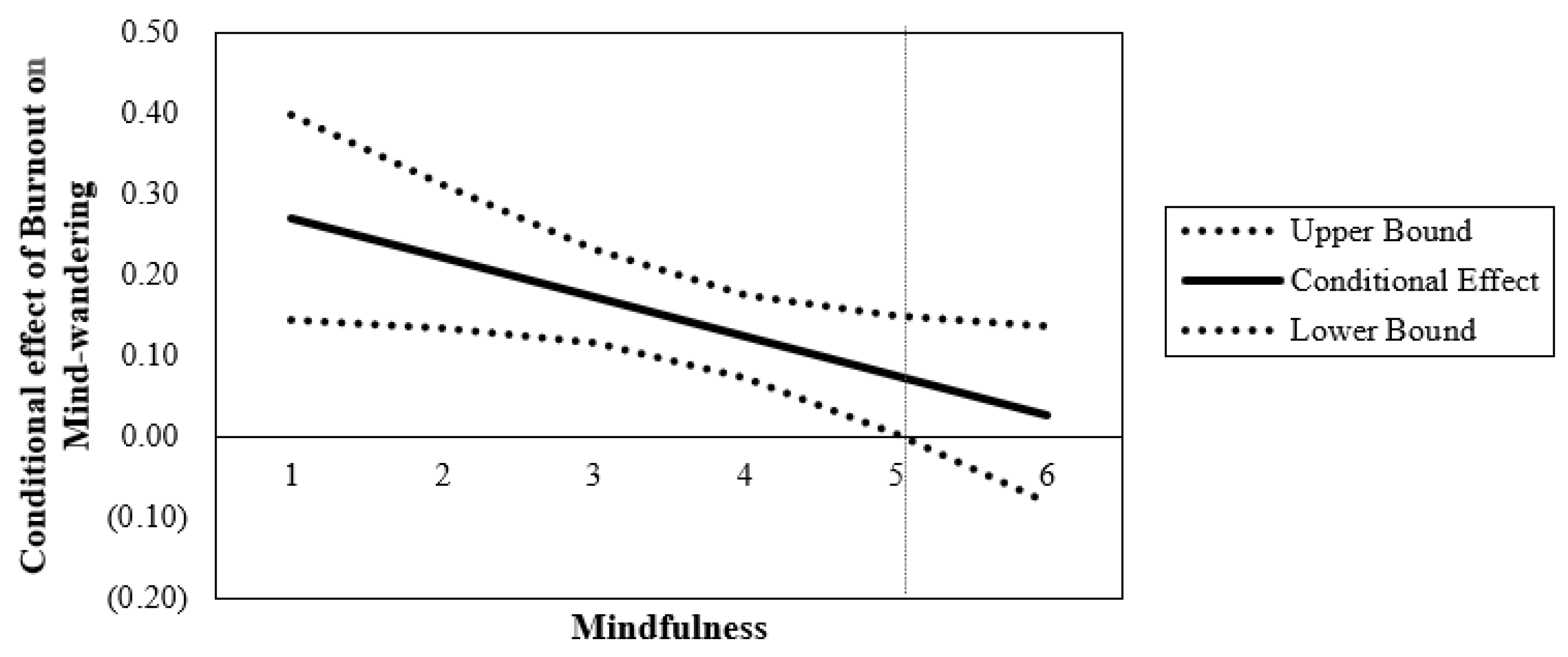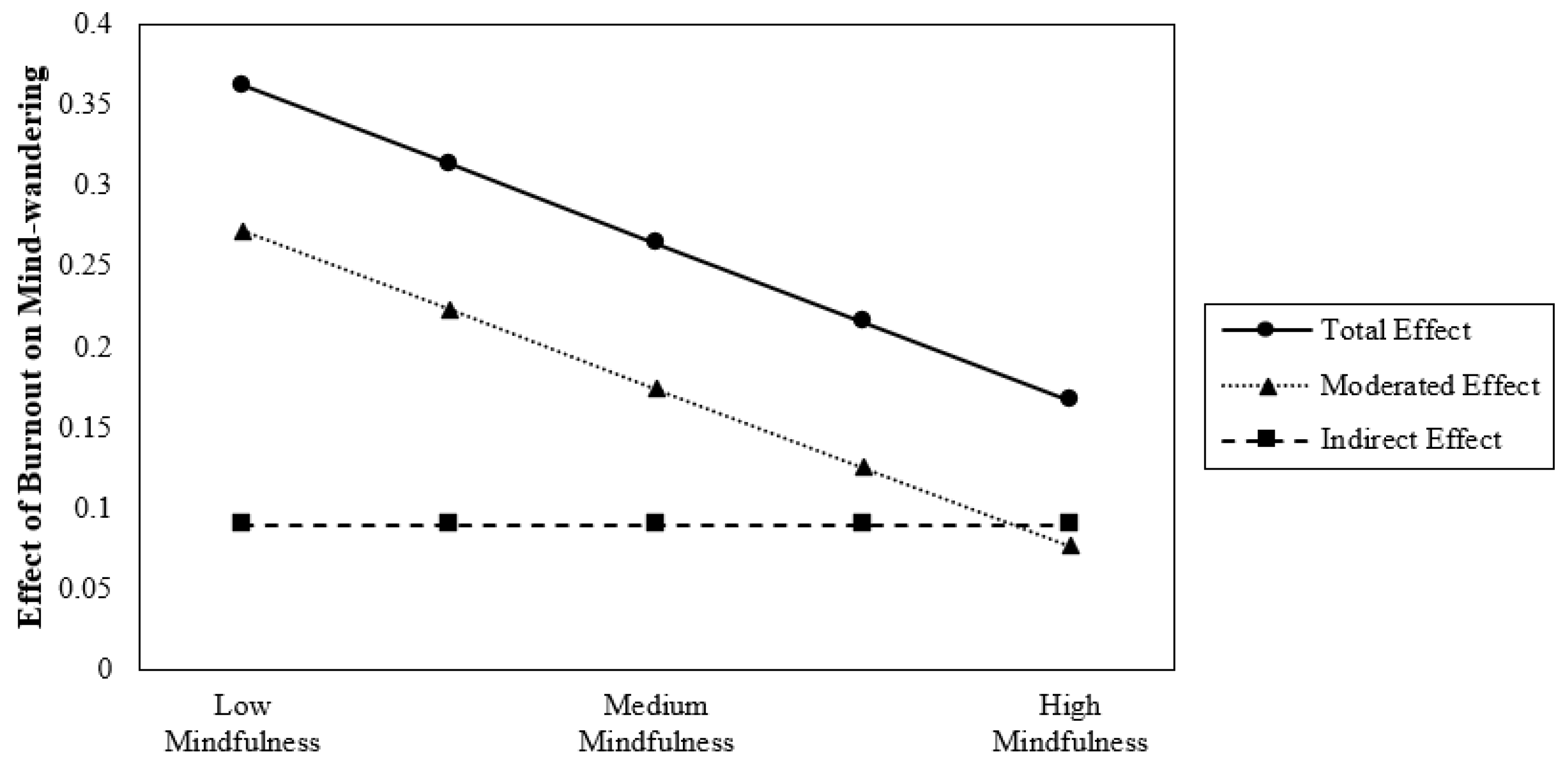Burnout and Attention Failure in STEM: The Role of Self-Control and the Buffer of Mindfulness
Abstract
1. Introduction
2. Theoretical Basis and Hypothesis Development
2.1. Chronic Self-Regulatory Depletion in Burnout
2.2. Mind-Wandering
2.3. The Role of Self-Control
2.4. The Role of Mindfulness
2.5. The STEM Context of the Present Investigation
3. Methods
3.1. Ethics Approval
3.2. Participants and Procedure
3.3. Measures
3.3.1. Burnout
3.3.2. Self-Control
3.3.3. Mind-Wandering
3.3.4. Mindfulness
4. Results
4.1. Analytical Strategy
4.2. Hypothesis Testing
4.3. Probing the Interaction
4.4. Putting It All Together
5. Discussion
5.1. Limitations
5.2. Practical Implications
6. Conclusions
Funding
Institutional Review Board Statement
Informed Consent Statement
Data Availability Statement
Conflicts of Interest
References
- Shirom, A. Job-related burnout: A review. In Handbook of Occupational Health Psychology; Quick, J.C., Tetrick, L.E., Eds.; American Psychological Association: Washington, DC, USA, 2003; pp. 245–264. [Google Scholar]
- Shirom, A. Job-related burnout: A review of major research foci and challenges. In Handbook of Occupational Health Psychology; Quick, J.C., Tetrick, L.E., Eds.; American Psychological Association: Washington, DC, USA, 2011; pp. 223–241. [Google Scholar]
- Wright, T.A.; Bonett, D.G. The contribution of burnout to work performance. J. Organ. Behav. 1997, 18, 491–499. [Google Scholar] [CrossRef]
- Halbesleben, J.R.; Buckley, M.R. Burnout in organizational life. J. Manag. 2004, 30, 859–879. [Google Scholar] [CrossRef]
- Sanchez-Gomez, M.; Breso, E. In pursuit of work performance: Testing the contribution of emotional intelligence and burnout. Int. J. Environ. Res. Public Health 2020, 17, 5373. [Google Scholar] [CrossRef] [PubMed]
- Trougakos, J.P.; Beal, D.J.; Cheng, B.H.; Hideg, I.; Zweig, D. Too drained to help: A resource depletion perspective on daily interpersonal citizenship behaviors. J. Appl. Psychol. 2015, 100, 227–236. [Google Scholar] [CrossRef] [PubMed]
- Lee, R.T.; Ashforth, B.E. A meta-analytic examination of the correlates of the three dimensions of job burnout. J. Appl. Psychol. 1996, 81, 123–133. [Google Scholar] [CrossRef] [PubMed]
- Liang, S.C.; Hsieh, A.T. Burnout and workplace deviance among flight attendants in Taiwan. Psychol. Rep. 2007, 101, 457–468. [Google Scholar] [CrossRef] [PubMed]
- Deng, H.; Walter, F.; Lam, C.K.; Zhao, H.H. Spillover effects of emotional labor in customer service encounters toward coworker harming: A resource depletion perspective. Pers. Psychol. 2017, 70, 469–502. [Google Scholar] [CrossRef]
- Raja, U.; Javed, Y.; Abbas, M. A time lagged study of burnout as a mediator in the relationship between workplace bullying and work–family conflict. Int. J. Stress Manag. 2017, 25, 377–390. [Google Scholar] [CrossRef]
- Galbraith, C.S.; Merrill, G.B. Academic performance and burnout: An efficient frontier analysis of resource use efficiency among employed university students. J. Furth. High. Educ. 2015, 39, 255–277. [Google Scholar] [CrossRef]
- Schaufeli, W.B.; Martínez, I.M.; Pinto, A.M.; Salanova, M.; Bakker, A.B. Burnout and engagement in university students: A cross-national study. J. Cross Cult. Psychol. 2002, 33, 464–481. [Google Scholar] [CrossRef]
- Kljajic, K.; Gaudreau, P.; Franche, V. An investigation of the 2 × 2 model of perfectionism with burnout, engagement, self-regulation, and academic achievement. Learn. Individ. Differ. 2017, 57, 103–113. [Google Scholar] [CrossRef]
- Toker, S.; Shirom, A.; Shapira, I.; Berliner, S.; Melamed, S. The association between burnout, depression, anxiety, and inflammation biomarkers: C-reactive protein and fibrinogen in men and women. J. Occup. Health Psychol. 2005, 10, 344–362. [Google Scholar] [CrossRef] [PubMed]
- Neveu, J.-P. Jailed resources: Conservation of resources theory as applied to burnout among prison guards. J. Organ. Behav. 2007, 28, 21–42. [Google Scholar] [CrossRef]
- Melamed, S.; Shirom, A.; Toker, S.; Berliner, S.; Shapira, I. Burnout and risk of cardiovascular disease: Evidence, possible causal paths, and promising research directions. Psychol. Bull. 2006, 132, 327–353. [Google Scholar] [CrossRef] [PubMed]
- Diestel, S.; Schmidt, K.-H. Costs of simultaneous coping with emotional dissonance and self-control demands at work: Results from two German samples. J. Appl. Psychol. 2011, 96, 643–653. [Google Scholar] [CrossRef] [PubMed]
- Leone, S.S.; Huibers, M.J.H.; Knottnerus, J.A.; Kant, I. A comparison of the course of burnout and prolonged fatigue: A 4-year prospective cohort study. J. Psychosom. Res. 2008, 65, 31–38. [Google Scholar] [CrossRef] [PubMed]
- May, R.W.; Seibert, G.S.; Sanchez-Gonzalez, M.A.; Fincham, F.D. Physiology of school burnout in medical students: Hemodynamic and autonomic functioning. Burn. Res. 2016, 3, 63–68. [Google Scholar] [CrossRef]
- Taris, T.W. Is there a relationship between burnout and objective performance? A critical review of 16 studies. Work Stress 2006, 20, 316–334. [Google Scholar] [CrossRef]
- Pandey, J.; Singh, M. Donning the mask: Effects of emotional labour strategies on burnout and job satisfaction in community healthcare. Health Policy Plan. 2016, 31, 551–562. [Google Scholar] [CrossRef] [PubMed]
- Yagil, D.; Medler-Liraz, H. Personally committed to emotional labor: Surface acting, emotional exhaustion and performance among service employees with a strong need to belong. J. Occup. Health Psychol. 2017, 22, 481–491. [Google Scholar] [CrossRef] [PubMed]
- Kim, J.; Youngs, P.; Frank, K. Burnout contagion: Is it due to early career teachers’ social networks or organizational exposure? Teach. Teach. Educ. 2017, 66, 250–260. [Google Scholar] [CrossRef]
- Halbesleben, J.R.B.; Bowler, W.M. Emotional exhaustion and job performance: The mediating role of motivation. J. Appl. Psychol. 2007, 92, 93–106. [Google Scholar] [CrossRef] [PubMed]
- Beal, D.J.; Weiss, H.M.; Barros, E.; MacDermid, S.M. An episodic process model of affective influences on performance. J. Appl. Psychol. 2005, 90, 1054–1068. [Google Scholar] [CrossRef] [PubMed]
- Gérain, P.; Zech, E. Informal caregiver burnout? Development of a theoretical framework to understand the impact of caregiving. Front. Psychol. 2019, 10, 466359. [Google Scholar] [CrossRef] [PubMed]
- Květon, P.; Jelínek, M.; Burešová, I. The role of perfectionism in predicting athlete burnout, training distress, and sports performance: A short-term and long-term longitudinal perspective. J. Sports Sci. 2021, 39, 1969–1979. [Google Scholar] [CrossRef] [PubMed]
- Jomuad, P.D.; Antiquina, L.M.M.; Cericos, E.U.; Bacus, J.A.; Vallejo, J.H.; Dionio, B.B.; Bazar, J.S.; Cocolan, J.V.; Clarin, A.S. Teachers’ workload in relation to burnout and work performance. Int. J. Educ. Policy Res. Rev. 2021, 8, 48–53. [Google Scholar]
- Dyrbye, L.N.; Shanafelt, T.D.; Johnson, P.O.; Johnson, L.A.; Satele, D.; West, C.P. A cross-sectional study exploring the relationship between burnout, absenteeism, and job performance among American nurses. BMC Nurs. 2019, 18, 57. [Google Scholar] [CrossRef] [PubMed]
- De Simone, S.; Vargas, M.; Servillo, G. Organizational strategies to reduce physician burnout: A systematic review and meta-analysis. Aging Clin. Exp. Res. 2021, 33, 883–894. [Google Scholar] [CrossRef] [PubMed]
- Witt, L.A.; Andrews, M.C.; Carlson, D.S. When conscientiousness isn’t enough: Emotional exhaustion and performance among call center customer service representatives. J. Manag. 2004, 30, 149–160. [Google Scholar] [CrossRef]
- Spence, J.R.; Keeping, L.M. The impact of non-performance information on ratings of job performance: A policy-capturing approach. J. Organ. Behav. 2010, 31, 587–608. [Google Scholar] [CrossRef]
- Silver, W.S.; Mitchell, T.R.; Gist, M.E. Responses to successful and unsuccessful performance: The moderating effect of self-efficacy on the relationship between performance and attributions. Organ. Behav. Hum. Decis. Process. 1995, 62, 286–299. [Google Scholar] [CrossRef]
- DeWitz, S.J.; Woolsey, M.L.; Walsh, W.B. College student retention: An exploration of the relationship between self-efficacy beliefs and purpose in life among college students. J. Coll. Stud. Dev. 2009, 50, 19–34. [Google Scholar] [CrossRef]
- Lemonaki, R.; Xanthopoulou, D.; Bardos, A.N.; Karademas, E.C.; Simos, P.G. Burnout and job performance: A two-wave study on the mediating role of employee cognitive functioning. Eur. J. Work Organ. Psychol. 2021, 30, 692–704. [Google Scholar] [CrossRef]
- Kleinsorge, T.; Diestel, S.; Scheil, J.; Niven, K. Burnout and the Fine-Tuning of Cognitive Resources. Appl. Cogn. Psychol. 2014, 28, 274–278. [Google Scholar] [CrossRef]
- Weiss, H.M.; Cropanzano, R. An affective events approach to job satisfaction. In Research in Organizational Behavior: Vol. 18; Staw, B.M., Cummings, L.L., Eds.; JAI Press: Stamford, CT, USA, 1996; pp. 1–74. [Google Scholar]
- Baumeister, R.F.; Heatherton, T.F. Self-regulation failure: An overview. Psychol. Inq. 1996, 7, 1–15. [Google Scholar] [CrossRef]
- Baumeister, R.F.; Vohs, K.D.; Tice, D.M. The strength model of self-control. Curr. Dir. Psychol. Sci. 2007, 16, 351–355. [Google Scholar] [CrossRef]
- van Dijk, D.M.; van Rhenen, W.; Murre, J.M.J.; Verwijk, E. Cognitive functioning, sleep quality, and work performance in non-clinical burnout: The role of working memory. PLoS ONE 2020, 15, e0231906. [Google Scholar] [CrossRef] [PubMed]
- Saxena, M. An Experience Sampling Analysis of Fatigue and Inhibition at Work. Ph.D. Thesis, Purdue University, West Lafayette, IN, USA, 2 November 2013. [Google Scholar]
- Otto, M.C.; Van Ruysseveldt, J.; Hoefsmit, N.; Van Dam, K. Examining the mediating role of resources in the temporal relationship between proactive burnout prevention and burnout. BMC Public Health 2021, 21, 599. [Google Scholar] [CrossRef] [PubMed]
- Schabram, K.; Heng, Y.T. How other-and self-compassion reduce burnout through resource replenishment. Acad. Manag. J. 2022, 65, 453–478. [Google Scholar] [CrossRef]
- Bakker, A.B.; Costa, P.L. Chronic job burnout and daily functioning: A theoretical analysis. Burn. Res. 2014, 1, 112–119. [Google Scholar] [CrossRef]
- Bolton, L.R.; Harvey, R.D.; Grawitch, M.J.; Barber, L.K. Counterproductive work behaviours in response to emotional exhaustion: A moderated mediational approach. Stress Health 2012, 28, 222–233. [Google Scholar] [CrossRef] [PubMed]
- Smallwood, J.; Schooler, J.W. The restless mind. Psychol. Bull. 2006, 132, 946–958. [Google Scholar] [CrossRef] [PubMed]
- Sarason, I.G.; Sarason, B.R.; Keefe, D.E.; Hayes, B.E.; Shearin, E.N. Cognitive interference: Situational determinants and traitlike characteristics. J. Pers. Soc. Psychol. 1986, 51, 215–226. [Google Scholar] [CrossRef]
- Coy, B.; O’Brien, W.H.; Tabaczynski, T.; Northern, J.; Carels, R. Associations between evaluation anxiety, cognitive interference and performance on working memory tasks. Appl. Cogn. Psychol. 2011, 25, 823–832. [Google Scholar] [CrossRef]
- Eysenck, M.W.; Derakshan, N.; Santos, R.; Calvo, M.G. Anxiety and cognitive performance: Attentional control theory. Emotion 2007, 7, 336–353. [Google Scholar] [CrossRef] [PubMed]
- Beilock, S.L.; Rydell, R.J.; McConnell, A.R. Stereotype threat and working memory: Mechanisms, alleviation, and spillover. J. Exp. Psychol. Gen. 2007, 136, 256–276. [Google Scholar] [CrossRef] [PubMed]
- Dixon, M.L.; Fox, K.C.R.; Christoff, K. A framework for understanding the relationship between externally and internally directed cognition. Neuropsychologia 2014, 62, 321–330. [Google Scholar] [CrossRef] [PubMed]
- Roczniewska, M.; Bakker, A.B. Burnout and self-regulation failure: A diary study of self-undermining and job crafting among nurses. J. Adv. Nurs. 2021, 77, 3424–3435. [Google Scholar] [CrossRef] [PubMed]
- Schmidt, K.-H.; Neubach, B.; Heuer, H. Self-control demands, cognitive control deficits, and burnout. Work Stress 2007, 21, 142–154. [Google Scholar] [CrossRef]
- Seibert, G.S.; May, R.W.; Fitzgerald, M.C.; Fincham, F.D. Understanding school burnout: Does self-control matter? Learn. Individ. Differ. 2016, 49, 120–127. [Google Scholar] [CrossRef]
- Tangney, J.P.; Baumeister, R.F.; Boone, A.L. High self-control predicts good adjustment, less pathology, better grades, and interpersonal success. J. Pers. 2004, 72, 271–324. [Google Scholar] [CrossRef] [PubMed]
- Baumeister, R.F. Self-regulation, ego depletion, and inhibition. Neuropsychologia 2014, 65, 313–319. [Google Scholar] [CrossRef] [PubMed]
- Gailliot, M.T.; Baumeister, R.F. Self-regulation and sexual restraint: Dispositionally and temporarily poor self-regulatory abilities contribute to failures at restraining sexual behavior. Pers. Soc. Psychol. Bull. 2007, 33, 173–186. [Google Scholar] [CrossRef] [PubMed]
- de Ridder, D.T.D.; Lensvelt-Mulders, G.; Finkenauer, C.; Stok, F.M.; Baumeister, R.F. Taking stock of self-control: A meta-analysis of how trait self-control relates to a wide range of behaviors. Pers. Soc. Psychol. Rev. 2012, 16, 76–99. [Google Scholar] [CrossRef] [PubMed]
- Baumeister, R.F.; Bratslavsky, E.; Muraven, M.; Tice, D.M. Ego depletion: Is the active self a limited resource? J. Pers. Soc. Psychol. 1998, 74, 1252–1265. [Google Scholar] [CrossRef] [PubMed]
- Kotabe, H.P.; Hofmann, W. On integrating the components of self-control. Perspect. Psychol. Sci. 2015, 10, 618–638. [Google Scholar] [CrossRef] [PubMed]
- Hofmann, W.; Schmeichel, B.J.; Baddeley, A.D. Executive functions and self-regulation. Trends Cogn. Sci. 2012, 16, 174–180. [Google Scholar] [CrossRef] [PubMed]
- Kaplan, S.; Berman, M.G. Directed attention as a common resource for executive functioning and self-regulation. Perspect. Psychol. Sci. 2010, 5, 43–57. [Google Scholar] [CrossRef] [PubMed]
- Kabat-Zinn, J. Mindfulness-based interventions in context: Past, present, and future. Clin. Psychol. Sci. Pract. 2003, 10, 144–156. [Google Scholar] [CrossRef]
- Mesmer-Magnus, J.; Manapragada, A.; Viswesvaran, C.; Allen, J.W. Trait mindfulness at work: A meta-analysis of the personal and professional correlates of trait mindfulness. Hum. Perform. 2017, 30, 79–98. [Google Scholar] [CrossRef]
- Friese, M.; Hofmann, W. State mindfulness, self-regulation, and emotional experience in everyday life. Motiv. Sci. 2016, 2, 1–14. [Google Scholar] [CrossRef]
- Allen, T.D.; Kiburz, K.M. Trait mindfulness and work–family balance among working parents: The mediating effects of vitality and sleep quality. J. Vocat. Behav. 2012, 80, 372–379. [Google Scholar] [CrossRef]
- Giluk, T.L. Mindfulness, big five personality, and affect: A meta-analysis. Pers. Individ. Differ. 2009, 47, 805–811. [Google Scholar] [CrossRef]
- Brown, K.W.; Ryan, R.M. The benefits of being present: Mindfulness and its role in psychological well-being. J. Pers. Soc. Psychol. 2003, 84, 822–848. [Google Scholar] [CrossRef] [PubMed]
- Canby, N.K.; Cameron, I.M.; Calhoun, A.T.; Buchanan, G.M. A brief mindfulness intervention for healthy college students and its effects on psychological distress, self-control, meta-mood, and subjective vitality. Mindfulness 2015, 6, 1071–1081. [Google Scholar] [CrossRef]
- Eberth, J.; Sedlmeier, P. The effects of mindfulness meditation: A meta-analysis. Mindfulness 2012, 3, 174–189. [Google Scholar] [CrossRef]
- Glomb, T.M.; Duffy, M.K.; Bono, J.E.; Yang, T. Mindfulness at work. In Research in Personnel and Human Resources Management; Martocchio, J., Liao, H., Joshi, A., Eds.; Emerald Group Publishing Limited: Bingley, UK, 2011; pp. 115–157. [Google Scholar]
- Mrazek, M.D.; Smallwood, J.; Schooler, J.W. Mindfulness and mind-wandering: Finding convergence through opposing constructs. Emotion 2012, 12, 442–448. [Google Scholar] [CrossRef] [PubMed]
- Guidetti, G.; Viotti, S.; Badagliacca, R.; Colombo, L.; Converso, D. Can mindfulness mitigate the energy-depleting process and increase job resources to prevent burnout? A study on the mindfulness trait in the school context. PLoS ONE 2019, 14, e0214935. [Google Scholar] [CrossRef] [PubMed]
- Portz, S. The Space Congress Proceedings Paper 3. 2015. Available online: http://commons.erau.edu/space-congress-proceedings/proceedings-2015-43rd/proceedings-2015-43rd/3 (accessed on 1 August 2023).
- Bozick, R. Making it through the first year of college: The role of students’ economic resources, employment, and living arrangements. Sociol. Educ. 2007, 80, 261–285. [Google Scholar] [CrossRef]
- Hall, N.C.; Sverdlik, A. Encouraging realistic expectations in STEM students: Paradoxical effects of a motivational intervention. Front. Psychol. 2016, 7, 1109. [Google Scholar] [CrossRef] [PubMed]
- Pedersen, D.E.; Minnotte, K.L. Workplace climate and STEM faculty women’s job burnout. J. Fem. Fam. Ther. Int. Forum 2017, 29, 45–65. [Google Scholar] [CrossRef]
- Wai, J.; Lubinski, D.; Benbow, C.P.; Steiger, J.H. Accomplishment in science, technology, engineering, and mathematics (STEM) and its relation to STEM educational dose: A 25-year longitudinal study. J. Educ. Psychol. 2010, 102, 860–871. [Google Scholar] [CrossRef]
- Saxena, M.; Geiselman, T.A.; Zhang, S. Workplace incivility against women in STEM: Insights and best practices. Bus. Hor. 2019, 62, 589–594. [Google Scholar] [CrossRef]
- Singer, J.L.; Antrobus, J.S. Manual for the Imaginal Processes Inventory; Educational Testing Service: Princeton, NJ, USA, 1970. [Google Scholar]
- Smeekens, B.A.; Kane, M.J. Working memory capacity, mind wandering, and creative cognition: An individual-differences investigation into the benefits of controlled versus spontaneous thought. Psychol. Aesthet. Creat. Arts 2016, 10, 389–415. [Google Scholar] [CrossRef] [PubMed]
- Luo, Y.; Zhu, R.; Ju, E.; You, X. Validation of the Chinese version of the Mind-Wandering Questionnaire (MWQ) and the mediating role of self-esteem in the relationship between mind-wandering and life satisfaction for adolescents. Pers. Individ. Differ. 2016, 92, 118–122. [Google Scholar] [CrossRef]
- Mason, M.F.; Norton, M.I.; Van Horn, J.D.; Wegner, D.M.; Grafton, S.T.; Macrae, C.N. Wandering minds: The default network and stimulus-independent thought. Science 2007, 315, 393–395. [Google Scholar] [CrossRef] [PubMed]
- Giambra, L.M. A factor analysis of the items of the imaginal processes inventory. J. Clin. Psychol. 1980, 36, 383–409. [Google Scholar] [CrossRef]
- Hayes, A.F. Introduction to Mediation, Moderation, and Conditional Process Analysis: A Regression-Based Approach; The Guilford Press: New York, NY, USA, 2018. [Google Scholar]
- Hayes, A.F.; Rockwood, N.J. Regression-based statistical mediation and moderation analysis in clinical research: Observations, recommendations, and implementation. Behav. Res. Ther. 2017, 98, 39–57. [Google Scholar] [CrossRef] [PubMed]
- Edwards, J.R.; Lambert, L.S. Methods for integrating moderation and mediation: A general analytical framework using moderated path analysis. Psychol. Methods 2007, 12, 1–22. [Google Scholar] [CrossRef] [PubMed]
- Preacher, K.J.; Hayes, A.F. Asymptotic and resampling strategies for assessing and comparing indirect effects in multiple mediator models. Behav. Res. Methods 2008, 40, 879–891. [Google Scholar] [CrossRef] [PubMed]
- Shrout, P.E.; Bolger, N. Mediation in experimental and nonexperimental studies: New procedures and recommendations. Psychol. Methods 2002, 7, 422–445. [Google Scholar] [CrossRef] [PubMed]
- Preacher, K.J.; Rucker, D.D.; Hayes, A.F. Addressing moderated mediation hypotheses: Theory, methods, and prescriptions. Multivar. Behav. Res. 2007, 42, 185–227. [Google Scholar] [CrossRef] [PubMed]
- MacKinnon, D.P.; Lockwood, C.M.; Williams, J. Confidence limits for the indirect effect: Distribution of the product and resampling methods. Multivar. Behav. Res. 2004, 39, 99–128. [Google Scholar] [CrossRef] [PubMed]
- Asher, H.B. Causal Modeling; Sage Publications: Thousand Oaks, CA, USA, 1983. [Google Scholar]
- Hayes, A.F. Methodology in the Social Sciences. In Introduction to Mediation, Moderation, and Conditional Process Analysis: A Regression-Based Approach; Guilford Press: New York, NY, USA, 2013. [Google Scholar]
- James, L.; Mulaik, S.; Brett, J.M. Causal Analysis: Assumptions, Models, and Data; Sage Publications: Thousand Oaks, CA, USA, 1982. [Google Scholar]
- Bernerth, J.B.; Aguinis, H. A critical review and best-practice recommendations for control variable usage. Pers. Psych. 2016, 69, 229–283. [Google Scholar] [CrossRef]
- O’Neill, T.A.; McLarnon, M.J.; Schneider, T.J.; Gardner, R.C. Current misuses of multiple regression for investigating bivariate hypotheses: An example from the organizational domain. Beh. Res. Methods 2014, 46, 798–807. [Google Scholar] [CrossRef] [PubMed]
- Bauer, D.J.; Curran, P.J. Probing interactions in fixed and multilevel regression: Inferential and graphical techniques. Multivar. Behav. Res. 2005, 40, 373–400. [Google Scholar] [CrossRef] [PubMed]
- Hayes, A.F.; Matthes, J. Computational procedures for probing interactions in OLS and logistic regression: SPSS and SAS implementations. Behav. Res. Methods 2009, 41, 924–936. [Google Scholar] [CrossRef] [PubMed]
- Hakanen, J.J.; Bakker, A.B. Born and bred to burn out: A life-course view and reflections on job burnout. J. Occup. Health Psychol. 2017, 22, 354–364. [Google Scholar] [CrossRef] [PubMed]
- Zivnuska, S.; Kacmar, K.M.; Ferguson, M.; Carlson, D.S. Mindfulness at work: Resource accumulation, well-being, and attitudes. Career Dev. Int. 2016, 21, 106–124. [Google Scholar] [CrossRef]
- Slutsky, J.; Chin, B.; Raye, J.; Creswell, J.D. Mindfulness training improves employee well-being: A randomized controlled trial. J. Occup. Health Psychol. 2018, 24, 139–149. [Google Scholar] [CrossRef] [PubMed]
- Podsakoff, P.M.; MacKenzie, S.B.; Podsakoff, N.P. Sources of method bias in social science research and recommendations on how to control it. Annu. Rev. Psychol. 2012, 63, 539–569. [Google Scholar] [CrossRef] [PubMed]
- Podsakoff, P.M.; MacKenzie, S.B.; Lee, J.Y.; Podsakoff, N.P. Common method biases in behavioral research: A critical review of the literature and recommended remedies. J. Appl. Psychol. 2003, 88, 879–903. [Google Scholar] [CrossRef] [PubMed]
- Conway, J.M.; Lance, C.E. What reviewers should expect from authors regarding common method bias in organizational research. J. Bus. Psychol. 2010, 25, 325–334. [Google Scholar] [CrossRef]
- Beal, D.J.; Weiss, H.M. Methods of Ecological Momentary Assessment in Organizational Research. Organ. Res. Methods 2003, 6, 440–464. [Google Scholar] [CrossRef]
- Beedie, C.J.; Lane, A.M. The role of glucose in self-control: Another look at the evidence and an alternative conceptualization. Pers. Soc. Psychol. Rev. 2012, 16, 143–153. [Google Scholar] [CrossRef] [PubMed]
- Inzlicht, M.; Schmeichel, B.J. What is ego depletion? Toward a mechanistic revision of the resource model of self-control. Pers. Psychol. Sci. 2012, 7, 450–463. [Google Scholar] [CrossRef]
- Trougakos, J.P.; Beal, D.J.; Green, S.G.; Weiss, H.M. Making the break count: An episodic examination of recovery activities, emotional experiences, and positive affective displays. Acad. Man. J. 2008, 51, 131–146. [Google Scholar] [CrossRef]
- Sonnentag, S.; Fritz, C. The Recovery Experience Questionnaire: Development and validation of a measure for assessing recuperation and unwinding from work. J. Occup. Health Psychol. 2007, 12, 204. [Google Scholar] [CrossRef] [PubMed]
- Ekstedt, M.; Söderström, M.; Åkerstedt, T. Sleep physiology in recovery from burnout. Bio. Psychol. 2009, 82, 267–273. [Google Scholar] [CrossRef] [PubMed]
- Schmeichel, B.J.; Vohs, K. Self-affirmation and self-control: Affirming core values counteracts ego depletion. J. Pers. Soc. Psychol. 2009, 96, 770–782. [Google Scholar] [CrossRef] [PubMed]





| Variables | M | SD | 1 | 2 | 3 | 4 |
|---|---|---|---|---|---|---|
| 3.59 | 1.01 | 0.90 | |||
| 3.36 | 0.51 | −0.45 ** | 0.87 | ||
| 3.80 | 0.86 | −0.38 ** | 0.43 ** | 0.89 | |
| 3.22 | 0.60 | 0.43 ** | −0.45 ** | −0.43 ** | 0.79 |
| Regression Results for the Total Effects Model | |||||
|---|---|---|---|---|---|
| Effects | Coefficient | SE | t | p | Model R2 |
| DV: Mind-wandering | |||||
| Constant | 2.29 | 0.09 | 25.82 | 0.000 | |
| Burnout | 0.26 | 0.02 | 10.88 | 0.000 | 0.19 *** |
| Mediation Model | |||||
| Direct Effects | Coefficient | SE | t | p | Model R2 |
| DV: Self-control | |||||
| Constant | 4.18 | 0.07 | 55.80 | 0.000 | |
| Burnout | −0.23 | 0.02 | −11.36 | 0.000 | 0.20 *** |
| DV: Mind-wandering | |||||
| Constant | 3.87 | 0.23 | 17.10 | 0.000 | |
| Burnout | 0.17 | 0.03 | 6.83 | 0.000 | |
| Self-control | −0.38 | 0.05 | −7.54 | 0.000 | 0.27 *** |
| Indirect Effect | Effect | Boot SE | Boot LLCI | Boot ULCI | |
| Burnout on Mind-wandering | 0.09 | 0.015 | 0.059 | 0.118 | |
| Moderation and Mediation Model | |||||
| Direct Effects | Coefficient | SE | t | p | Model R2 |
| DV: Self-control | |||||
| Constant | 3.36 | 0.02 | 164.44 | 0.000 | |
| Burnout | −0.23 | 0.02 | −11.37 | 0.000 | 0.20 *** |
| DV: Mind-wandering | |||||
| Constant | 4.26 | 0.18 | 24.11 | 0.000 | |
| Burnout | 0.14 | 0.03 | 5.32 | 0.000 | |
| Self-control | −0.31 | 0.05 | −5.94 | 0.000 | |
| Mindfulness | −0.15 | 0.03 | −5.09 | 0.000 | |
| Burnout*Mindfulness | −0.05 | 0.02 | −2.25 | 0.025 | 0.32 *** |
| Conditional direct effects | Index | Boot SE | Boot LLCI | Boot ULCI | |
| Low mindfulness | 0.174 | 0.030 | 0.116 | 0.233 | |
| Medium mindfulness | 0.135 | 0.026 | 0.085 | 0.186 | |
| High mindfulness | 0.093 | 0.032 | 0.029 | 0.157 | |
| Indirect Effect | Effect | Boot SE | Boot LLCI | Boot ULCI | |
| Burnout on Mind-wandering | 0.07 | 0.014 | 0.046 | 0.010 | |
Disclaimer/Publisher’s Note: The statements, opinions and data contained in all publications are solely those of the individual author(s) and contributor(s) and not of MDPI and/or the editor(s). MDPI and/or the editor(s) disclaim responsibility for any injury to people or property resulting from any ideas, methods, instructions or products referred to in the content. |
© 2024 by the author. Licensee MDPI, Basel, Switzerland. This article is an open access article distributed under the terms and conditions of the Creative Commons Attribution (CC BY) license (https://creativecommons.org/licenses/by/4.0/).
Share and Cite
Saxena, M. Burnout and Attention Failure in STEM: The Role of Self-Control and the Buffer of Mindfulness. Int. J. Environ. Res. Public Health 2024, 21, 1000. https://doi.org/10.3390/ijerph21081000
Saxena M. Burnout and Attention Failure in STEM: The Role of Self-Control and the Buffer of Mindfulness. International Journal of Environmental Research and Public Health. 2024; 21(8):1000. https://doi.org/10.3390/ijerph21081000
Chicago/Turabian StyleSaxena, Mahima. 2024. "Burnout and Attention Failure in STEM: The Role of Self-Control and the Buffer of Mindfulness" International Journal of Environmental Research and Public Health 21, no. 8: 1000. https://doi.org/10.3390/ijerph21081000
APA StyleSaxena, M. (2024). Burnout and Attention Failure in STEM: The Role of Self-Control and the Buffer of Mindfulness. International Journal of Environmental Research and Public Health, 21(8), 1000. https://doi.org/10.3390/ijerph21081000







